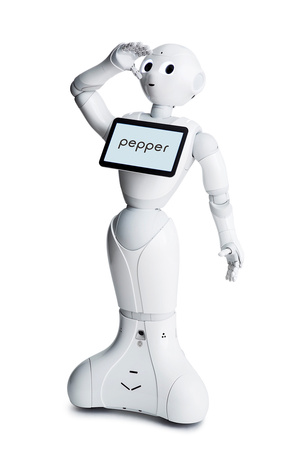Don't Panic!
Two hundred years ago economists and intellectuals were concerned that “The Machinery Question” was going to ruin the lives of working people. Yet the lives of people today are better, safer, easier and possibly more enjoyable than they were then. The fear was that what we now call the industrial revolution (the introduction of Machinery to undertake routine human tasks) was going to make people redundant, destroy livelihoods and cause fractures in society. 200 years later the overall effect of mechanisation has been to create jobs, albeit new sorts of jobs, rather than destroy them.
We can but hope that the same is going to be true for AI.
AI gets GO, AI gets going
I first encountered neural nets back in the 1970s when I shared a lab with Igor Aleksander, now an Emeritus Professor at Imperial College, who was building layered neural networks, very like those that are delivering such powerful outcomes today. Results then were limited by the depth of the networks, the speed of processing, and the training data sets. AI went into the wilderness, only to return to favour around 2012 when more powerful AI programs started to perform better than humans on tasks like the ImageNet challenge – recognising features in images. The best recent example is perhaps when AlphaGo unexpectedly beat the world champion at Go.
We are witnessing the onset of what I suggest we call “ASAI”, application-specific AI: being able to solve specific problems and solve them better than humans can. Great, so what? Is it going to drive a fundamental change in society? We can improve our ability to screen medical images, or analyse failures of mechanical equipment, or even drive cars. Important but not apocalyptic.
An AI-based security scanner can be more efficient and more consistent than the manual ones used today, where the poor operators have to look at weird images of our luggage to detect if we have a bomb hidden under our folding umbrella. I can’t see this change being anything other than beneficial to travellers and operators.
There are more important and complex tasks where the AI device advises and suggests, rather than decides. Medical diagnostics for example, where signs might be picked up by the AI that can guide the doctor. Again, probably doctors and patients would welcome such an approach. Nearly half of patients have already indicated that they would prefer to deal with a “computer” than a person when discussing their ailments, presumably if they trusted the outcome.
Meet Pepper
 Pepper is a cute robot from SoftBank, the Japanese company which now owns ARM. It gives an endearingly human face to technology by having very childlike movements and huge eyes. But Pepper’s role in replacing staff in shops will be seen by some every bit as job threatening as the spinning jenny and Deepmind’s AlphaGo.
Pepper is a cute robot from SoftBank, the Japanese company which now owns ARM. It gives an endearingly human face to technology by having very childlike movements and huge eyes. But Pepper’s role in replacing staff in shops will be seen by some every bit as job threatening as the spinning jenny and Deepmind’s AlphaGo.
AGI or ASAI?
We deal with AI more than we realise. Of course the most obvious place for implementation of such power-hungry computing is in web services. So all the web marketplace vendors use AI to tailor the way they offer their products to us as we navigate their site. My view here is that some of this seems pretty “Mickey Mouse”. The fact that I have bought a washing machine does not necessarily mean that I am ready to change my favourite washing powder. On the other hand perhaps it is so subtle that I haven’t noticed that I am being fed offers that I find attractive and take up.
All three of these examples are ASAI. They replace, support or improve the delivery of existing products and services. I doubt that they presage a fundamental change in society that we need to panic about. It looks to me like a modern version of The Machinery Question: jobs will be lost and new ones (probably better ones) will be made.
But there is more to come: Artificial General Intelligence (AGI), a non-human machine that behaves like an intelligent being. The Turing Test is well-known, but more relevant may be the Wozniak Test: the ability to enter an unknown property and independently make a cup of coffee. AGI is way more significant than ASAI. Sufficiently so that very clever people like Stephen Hawking and Elon Musk and Prof Nick Bostrom from Oxford are concerned about superintelligence. Concerned that we are creating something that we can’t control and which will out-perform and supersede us; as Hawking points out the pace of change in artificial systems is much greater than the Darwinian pace of biological systems – we won’t be able to keep up. I think that they are right to be concerned, but that we have plenty of time to deal with the topic. After all whilst DeepMind’s AlphaGo is extremely clever to beat Ke Jie at Go, I doubt that the Korean has a problem making a cup of coffee.
AGI will appear, the question is when? Recent progress in ASAI has been so impressive that it makes prediction difficult, but Ray Kurzweil has suggested before 2045 and many agree.
AI: As intelligent as humans … which humans exactly?
I suspect it is more difficult. Remember Eliza? Created in the late 1960s Eliza was a text-based natural language program that gave the illusion of intelligence through rules and directions that were pre-programmed, without any inherent understanding. Surprisingly, many users were convinced of Eliza’s intelligence. (If you want to give it a go, click here - it is not overwhelming.) Might the same not be true for AGI: it will be easy to over-estimate the intelligence of the AGI; which raises something of a philosophical question – how do you judge when something is more intelligent than you are? Ask it to do things you can’t do? Ask it questions you don’t know the answer to?
By the time that AGI is a threat to society we’ll be able to pick up our copy of The Hitchhiker’s Guide to the Galaxy and take in that immortal phrase on the cover: “Don’t Panic”
Tony Milbourn
VP of Strategy, u-blox

Tony Milbourn is responsible for Strategy at u-blox AG. He has 30 years’ experience in the mobile communications industry. He was a founder and CEO of TTP Communications plc, a major licensing business in cellular acquired in 2006 by Motorola: a founder of ip.access, the leading femtocell business: and more recently led the spin-out of a soft modem start-up, Cognovo, from ARM Holdings. He is interested in creating new opportunities at the point where communications and computing converge.
Continue the conversation on Twitter. Follow us on @cwjpress and use hashtags #cwjournal and #peppertherobot
This article was originally published in the CW Journal: Volume One, Issue Two.
If you would like to receive a free copy of the CW Journal, please submit your details here. The CW Journal Editorial Board welcomes comment from those of you who would like to submit an article - simply email your synopsis to the team.
Pg 6-7
